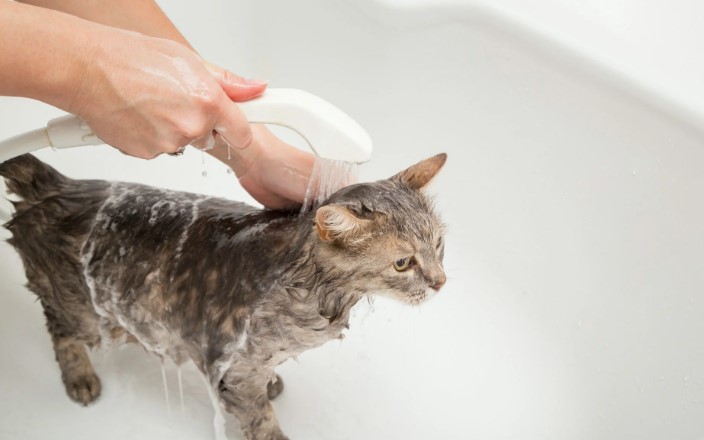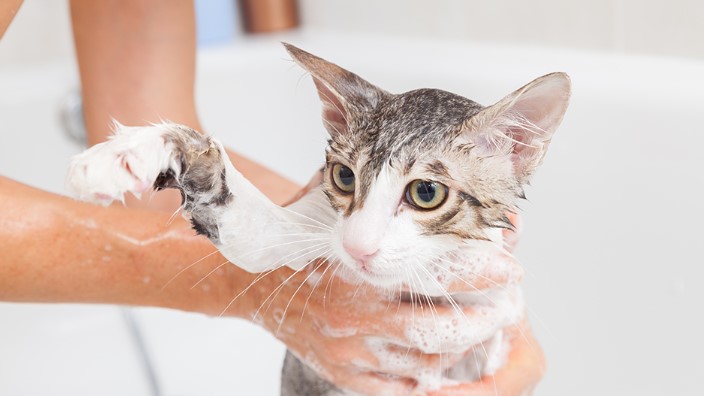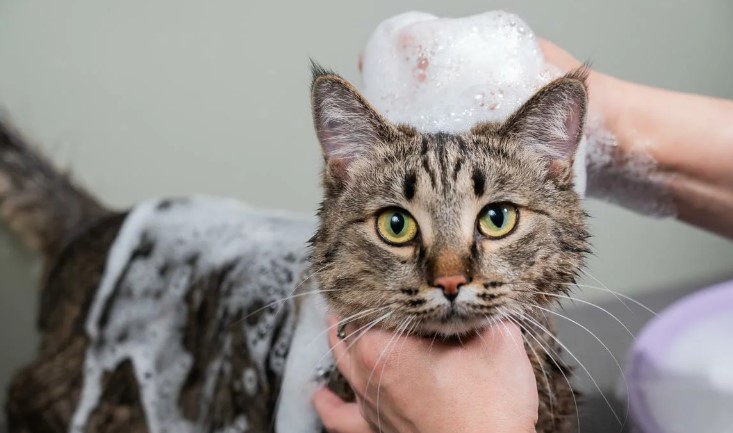How to bathe a cat without the chaos? I’ve got you covered with simple, stress-free tips that actually work. Let’s make bath time easy!
I used to dread giving my cat a bath. Like, actual sweaty palms and full-on negotiations with a five-pound furball. My old tabby, Mochi, would turn into a ninja the second she saw water. One time, she leaped out of the tub mid-bath and bolted down the hallway, covered in suds like a runaway soap opera. I laughed later—but in the moment, it was chaos.
If you’ve ever tried to bathe a cat, you know it can feel like defusing a bomb with oven mitts. But here’s the truth no one tells you—it doesn’t have to be a battle. Once I learned a few tricks (and a lot of patience), bath time became way less dramatic. Now, I can actually say I survive it with my skin intact—and so can you.
That’s why I put together this guide. If you’re a first-time cat owner or just someone who’s never quite mastered the art of feline hygiene, this is for you.
In this guide, you’ll learn:
- Why cats even need baths (yep, not all of them do!)
- How to prep your space (and your cat)
- Step-by-step bath instructions that actually work
- Tips to keep your kitty calm—and you sane
- What to do after the bath so they don’t hate you forever
I’ll walk you through it all, sharing what’s worked (and what flopped) from my own experience. No confusing lingo. No judgment. Just real, helpful advice—cat lover to cat lover. Ready? Let’s turn bath time into something you both can handle—maybe even enjoy (okay, maybe is the keyword here).

Do Cats Really Need Baths?
This might surprise you, but most cats don’t need regular baths. Honestly, the first time I Googled “how often should I bathe my cat?” I expected to find some monthly schedule like we have for dogs. But nope. Cats are basically self-cleaning machines. It’s like they’re born with a built-in Swiffer system—always grooming, always fussing over their fur.
That said, there are times when a bath isn’t just helpful—it’s necessary. I learned this the hard way when my cat rolled in motor oil under the neighbor’s car. No tongue in the world could fix that mess. And then there was the flea incident. Shudder. I still get itchy just thinking about it.
So, when does a cat actually need a bath?
When a Bath Is Needed
Here are a few cases where a bath makes sense:
- Fleas or ticks: If your vet recommends a medicated bath, it can help break the flea cycle.
- Sticky or oily substances: Like engine grease, paint, syrup—yes, syrup. Don’t ask.
- Allergies or skin issues: Some conditions need special shampoos to calm irritation.
- Senior cats or those with obesity: These kitties might have trouble grooming hard-to-reach spots.
- Hairless breeds: Cats like Sphynx need regular bathing since their skin gets oily.
I’ve had to bathe a cat after a messy accident involving chocolate frosting. Not fun. Not safe for cats either. That’s another time when a quick bath saved the day.

When It’s Better to Skip the Bath
Most of the time, brushing does the trick. Here’s when to keep the towel dry:
- Your cat is healthy and self-grooming. No need to mess with what nature does best.
- She’s anxious or aggressive. A forced bath could do more harm than good.
- There’s no real mess. A damp washcloth works wonders for mild dirt or dust.
- Your vet says no. Some cats with health issues shouldn’t be bathed at home.
I always start with a gentle brush first. If my cat seems calm and the dirt isn’t too deep, I skip the full wash. It’s less stress for both of us—and my arms stay scratch-free.
To Bathe or Not to Bathe?
Here’s a quick visual to help you decide:
| Situation | Bath Needed? | What to Do |
|---|---|---|
| Rolled in something sticky | Yes | Use mild cat shampoo |
| Covered in fleas | Yes | Use vet-approved flea shampoo |
| Slightly dusty from the backyard | No | Brush or use damp cloth |
| Skin rash or infection | Yes | Ask vet for medicated shampoo |
| Old or overweight cat | Sometimes | Help with grooming or bathe if needed |
| Normal self-grooming cat | No | Just regular brushing |
So, not every cat needs a bubble bath—but when they do, it’s good to know how to do it right. And trust me, doing it the right way makes all the difference.
How to Prepare for a Cat Bath (Without the Drama)
Okay, let’s be real—bathing a cat isn’t something you just wing. Trust me, I’ve tried that. Once. It ended with me soaked, the bathroom wrecked, and my cat hiding under the bed like I’d betrayed her deepest trust. Lesson learned.
The key to a smooth bath? It’s all in the prep. Think of it like setting the stage for a peaceful performance—less Broadway, more spa day. And yes, cats can have spa days… if you play your cards right.

Gather Your Supplies First
Before you even say the word “bath,” make sure you’ve got everything laid out and within reach. You do not want to go searching for a towel mid-bath with a soggy, wriggling cat in your arms.
Here’s my go-to checklist:
- Cat-safe shampoo – Never use human or dog shampoo. Their skin has a different pH. I use a gentle, unscented one made just for cats.
- Towels (plural) – One for drying, one for gripping. I keep an extra nearby just in case things get splashy.
- Cup or sprayer – I like a plastic cup to rinse gently. If you use a sprayer, test the pressure first. It should feel like a soft rain, not a power wash.
- Treats & toys – These are your peace offerings. I always keep a few tasty bites on hand and a favorite toy nearby to help distract and reward.
Here’s a little tip I wish I knew earlier: Set everything up like you’re prepping for a newborn. Calm vibes. Soft voices. A towel ready to wrap. The less noise and fuss, the better.
Trim the Claws (Optional… but Smart)
If your cat turns into a tiny ninja during bath time, trimming her claws beforehand can really help. I’m not saying it’ll save you from every scratch, but it reduces the risk of accidental “battle wounds.”
I usually do this the day before, when she’s relaxed. Trying to cut claws right before a bath is like lighting a firecracker next to a sleeping dragon. Just… no.
Getting everything ready in advance makes a huge difference. It’s like prepping for a camping trip—you can enjoy the experience more when you’re not missing socks or fumbling with flashlights. Same goes for cat baths.
How to Bathe a Cat Safely –Step by Step Process
Alright, deep breath. This is the part most cat parents dread—and I totally get it. I used to think bathing a cat was basically signing up for a WWE match. But once I learned how to take it slow and keep things calm, it changed everything. Now? It’s more like a strange bonding ritual… with a splash.
Let me walk you through it, one gentle step at a time.
1.Calm Your Cat First
Think of this as the warm-up before the main act. If your cat is already nervous, jumping straight into the tub will only make things worse (for both of you).
Here’s what works for me:
- Find a quiet space — Close doors and block loud noises. The bathroom works best.
- Start with soft petting — I always give her a slow, gentle stroke along the back. Sometimes I even hum. It sounds silly, but the rhythm helps both of us relax.
- Use treats and praise — I keep her favorite snack handy and talk to her like she’s royalty. “You’ve got this, sweet girl. Just a little spa time.” It helps keep the mood light.
If your cat is the nervous type, try rubbing a bit of calming spray on a towel or using a pheromone diffuser in the room beforehand. It’s like aromatherapy for cats
2.Gently Wet the Cat
Once she’s calm (or at least not glaring at me), it’s go time. I always test the water first—lukewarm is key. Too cold and they shiver, too hot and you’ve lost their trust for life.
Here’s what I do:
- Use a cup or handheld sprayer with low pressure. Think soft summer rain, not kitchen faucet blast.
- Start from the neck down. Keep the water away from her face, ears, and eyes. Those spots are sacred.
- Wet her slowly. I pour gently down the back, then work toward her sides and tail.
I never rush this part. The slower and softer I go, the less panicked she gets.
3. Lather and Rinse
Now, it’s shampoo time. But here’s the thing—less is more. A small coin-sized amount is usually enough.
- Use cat-safe shampoo only. Human stuff is a big no (even if it smells amazing).
- Lather gently, using small circular motions like a cat massage.
- Rinse thoroughly. Leftover soap can irritate her skin, and trust me, you don’t want a cat scratching at an itch all day.
I rinse until the water runs totally clear. It takes a few passes, but it’s worth it.
4. Drying Off Properly
Time to towel off! I grab a soft, absorbent towel and wrap her up like a little burrito. She usually gives me a soggy stink-eye, but the towel swaddle helps her feel safe.
- Pat, don’t rub. Rubbing can tangle fur or annoy sensitive skin.
- If your cat is okay with it, a hair dryer on low (cool setting) works wonders. But go slow. Keep it far from her face and watch her body language.
- Keep the room warm while she dries. I close windows and avoid fans.
Some cats like to hide after bath time—and that’s okay. I let her retreat to her cozy corner, then offer treats later as a peace offering.
5. Quick Do’s and Don’ts of Bathing a Cat
| Do | Don’t |
|---|---|
| Use lukewarm water | Use cold or hot water |
| Speak calmly throughout | Yell or make sudden movements |
| Use cat-specific shampoo | Use human or dog shampoo |
| Rinse thoroughly | Leave shampoo residue |
| Dry with soft towel (or low dryer) | Use high heat or force |
| Offer treats and comfort afterward | Force them back into water if scared |
Once I started following these steps, bath time stopped being a battlefield. It became something softer. A moment of care. And even if she still gives me the side-eye sometimes, I can tell she feels better afterward.
Tips for Bathing Nervous or Aggressive Cats
Alright, so let’s be real—some cats act like you’ve just insulted their ancestors the moment they see a drop of water. If your cat turns into a ninja during bath time, don’t worry. I’ve been there too. My tabby, Luna, once did a full backflip out of the tub. I swear, it was like watching Cirque du Soleil… with claws.
Here’s how I’ve learned to make it easier (and safer) for both of us.
Try Calming Sprays or Pheromone Diffusers
Before bath time, I spritz the room lightly with a feline calming spray. I like the kind that mimics natural cat pheromones—it’s like aromatherapy for kitties. If your cat gets extra twitchy, plug in a pheromone diffuser about 30 minutes before the bath. Think of it like mood lighting for a spa day—minus the candles and pan flute music.
Wrap ‘Em Like a Purrito (Seriously)
For cats who scratch like they’re fencing champions, I use the towel wrap method—also called the “cat burrito.” Gently wrapping your cat in a soft towel helps keep their limbs controlled and gives them a sense of security. Only expose the part you’re washing. It’s like baby steps for bathing. This trick has saved my arms more times than I can count.
Bring a Bath Buddy
If you can, get someone your cat trusts to help. My sister holds Luna and talks to her while I wash. Just having a familiar voice nearby makes a big difference. And trust me, four hands are better than two when the claws come out.
Know When to Skip It
Sometimes, it’s just not worth the stress. If your cat is super aggressive or scared, don’t force it. There’s no shame in calling a professional groomer. Some groomers even do home visits now, so your cat doesn’t have to leave their comfort zone. I always say—if it’s between your cat hating you for a week or getting expert help, pick peace.
Best Products to Use (And What to Avoid)
Now, let’s talk about what goes on your cat’s skin. I learned the hard way that not all shampoos are safe—even ones that smell great or are fine for dogs.
Stick to Cat-Only Shampoos
Cats have sensitive skin and different pH levels than dogs or humans. I always use shampoos labeled for cats only. No shortcuts here. Even a mild human shampoo can throw off their skin balance or make them sick if they lick it.
Hypoallergenic or Flea-Safe Options
If your cat has allergies (Luna sneezes like a cartoon character), go for hypoallergenic formulas. And if fleas are the issue, there are special flea shampoos for cats—but make sure they don’t contain harsh chemicals.
Avoid These Ingredients
Some things that are safe for us are dangerous for cats. Here’s a quick no-go list I always keep in mind:
- Essential oils (especially tea tree, eucalyptus, and citrus oils)
- Artificial dyes or fragrances
- Alcohol-based cleansers
- Parabens and sulfates
If the label sounds like a chemistry class, I skip it.
| Safe for Cats | Not Safe for Cats |
|---|---|
| Fragrance-free cat shampoo | Human shampoo |
| Hypoallergenic formulas | Dog shampoo with flea meds |
| Cat flea shampoo (vet-approved) | Essential oils (like tea tree) |
| Oatmeal-based cat shampoo | Parabens or artificial dyes |
Alternatives to a Full Bath
Let’s be real—bathing a cat isn’t always easy. Some cats act like you’ve just suggested skydiving… without a parachute. So if your fur baby hates water or if the mess isn’t that bad, there are easier ways to keep them clean.
Waterless Shampoo
This stuff is a life-saver. I once had to deal with a cat who rolled in something funky outside. No way was I getting him into the tub, so I tried a waterless shampoo foam. Just rubbed it in, let it sit, and brushed it out. Magic.
Look for a cat-specific formula—never use one made for dogs or humans. Those can irritate your cat’s skin.
Grooming Wipes
If you’re dealing with mild dirt or dander, wipes are perfect. I always keep a pack near the litter box, just in case. It’s kind of like giving your cat a little sponge bath without the drama.
Choose unscented, alcohol-free wipes made for cats. They’re gentle and won’t dry out the skin.
Regular Brushing
Sometimes, a good brush is all it takes. I brush my long-haired girl every evening. Not only does it keep her coat clean, but it also helps us bond. She purrs the whole time like we’re having a spa night.
Short-haired cats need it too, just not as often. It also helps cut down on hairballs. Win-win.
Spot-Cleaning Dirty Areas
If your cat just has a bit of gunk near the paws or tail, grab a damp cloth and gently clean the spot. That’s it. No full soak needed. I’ve done this after “litter box accidents” more times than I can count.
Aftercare: What to Do After the Bath
The bath is done. You’re both alive. Time to breathe. But don’t stop caring just yet—aftercare is key.
Comfort Your Cat with Treats
First thing I do? Grab the treats. A few of their favorites go a long way in making sure your cat doesn’t hold a grudge. Think of it like a peace offering. It helps turn a stressful moment into something rewarding.
Monitor for Signs of Stress
Some cats bounce back fast. Others need time. Watch how they act afterward. If your cat hides, pants, or acts jumpy, just give them space. Sit nearby so they know you’re there, but don’t force cuddles.
I once had a cat who didn’t come out from under the bed for two hours. I sat outside the room reading aloud. She finally poked her head out when I opened a can of tuna.
Keep Them Warm and Dry
Wrap your cat in a soft towel. Hold them close (if they’ll allow it). I like to pre-warm the towel in the dryer. It’s like wrapping them in a hug. You can also use a blow dryer on the lowest heat, but only if your cat is okay with it. Always keep a hand between the dryer and the fur to check the temp.
Common Mistakes to Avoid
Bathing a cat comes with a learning curve. I’ve made these mistakes so you don’t have to.
| Mistake | Why It’s a Problem | What to Do Instead |
|---|---|---|
| Bathing too often | Can dry out the skin and cause stress | Bathe only when truly needed |
| Using the wrong shampoo | Some ingredients are harmful to cats | Use cat-only shampoos with safe ingredients |
| Rushing the process | Can make your cat panic or feel cornered | Move slow and talk to your cat gently |
| Not rinsing thoroughly | Shampoo residue can irritate skin | Rinse until water runs completely clear |
| Skipping aftercare | Can leave your cat cold, scared, or confused | Comfort, dry, and reward your cat post-bath |
I’ve rushed a bath once out of fear my cat would scratch me. She ended up stressed, and I ended up soaked. Taking my time the next round made all the difference.
FAQ: Bathing Your Cat
Alright, let’s clear up a few common questions I get all the time from fellow cat parents. I’ve asked these myself, usually mid-bath with my cat yowling like he’s starring in a soap opera. So if you’re wondering the same things, you’re not alone.
Q. How often should I bathe my cat?
Honestly? Not that often. Most cats are self-cleaning champs. I usually only bathe mine if he gets into something sticky or smelly (like the time he rolled in soy sauce… don’t ask).
- For indoor cats, once every few months—or even once a year—is usually enough.
- Long-haired breeds or older cats who can’t groom well might need it a bit more.
Q. Can I use baby shampoo on my cat?
I used to think baby shampoo was gentle enough—and it sounds like a sweet idea, right? But the truth is, it’s not designed for a cat’s skin. Their pH is different from ours.
- Stick with a cat-specific shampoo. It’s made to be safe if they lick themselves later.
- Avoid anything with essential oils unless your vet gives the thumbs-up.
Q. What if my cat hates water?
Ah, welcome to the club. Mine acts like the tub is lava. If your cat really hates baths, try:
- Waterless shampoo: Great for in-between clean-ups.
- Grooming wipes: Like kitty wet wipes.
- Spot-cleaning: Just tackle the dirty areas with a damp cloth.
Small wins matter. You don’t have to dunk them every time.
Q. Is it safe to bathe kittens?
Yes, but only if you really need to. Kittens are delicate and get cold fast.
- Wait until they’re at least 8 weeks old.
- Use warm water, a soft towel, and be super gentle.
- Keep it short and cozy them up right after.
Pro tip: Use a damp cloth instead of a full bath for tiny messes. Less drama, more cuddles.
Q. How long does it take to bathe a cat?
If all goes well (and that’s a big if), it can take about 10–15 minutes.
- Setup and drying will add extra time.
- Don’t rush. The calmer you are, the quicker it usually goes.
I’ve had baths take five minutes and others feel like an Olympic event. Just breathe and roll with it.
Final Thoughts
If your first cat bath feels like herding a wet, angry tornado—don’t worry, I’ve been there.
Bathing your cat gets easier with time. The more relaxed you are, the more your cat will feed off that energy. Be gentle. Use positive words. Offer a treat or their favorite toy after. And always—always—reward yourself with a cup of tea or a deep breath when it’s done.
Caring for a cat is a journey full of surprises, fur, and the occasional water fight. If you’ve got a funny or sweet bath story, I’d love to hear it. Share your experiences in the comments—I promise, you’re in good company.


